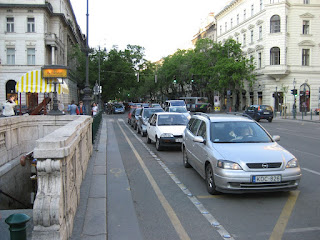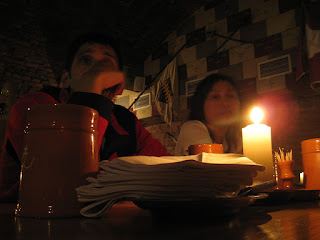For the Easter weekend in Germany, the Friday and Monday are public holidays. So I went with a few friends to Krakow, Poland. This is a very beautiful city in southern Poland, about 500km east of Dresden. We rented a car, and headed off on Friday morning. Unfortunately, winter finally decided to show up during the long weekend.
 This is the first time I've seen accumulated snow since I've been in Germany.
This is the first time I've seen accumulated snow since I've been in Germany.
 Now that Poland is part of the Schengen countries, border control has been removed. But there were still police on the side of the road waiting to pull over suspicious cars.
Now that Poland is part of the Schengen countries, border control has been removed. But there were still police on the side of the road waiting to pull over suspicious cars.
 We stopped by a Polish mall to get some food. I was baffled at how much like America this looked like.
We stopped by a Polish mall to get some food. I was baffled at how much like America this looked like.
 And those familiar evil golden arches...
And those familiar evil golden arches...
We eventually got to Krakow after an 8h trip. There was an accident that was holding up traffic. We checked into our hotel, and started to walk around the city.
 This is the center of the old city. It is a large square with a market, several churches, and of course restaurants.
This is the center of the old city. It is a large square with a market, several churches, and of course restaurants.
 A food stall serving some Polish street food, including some tasty polish sausage.
A food stall serving some Polish street food, including some tasty polish sausage.
 Mmmm, some tasty grilled meat.
Mmmm, some tasty grilled meat.
 Oddly enough, there was only 1 stand serving alcohol. If this was Germany, there would be plenty of beer.
Oddly enough, there was only 1 stand serving alcohol. If this was Germany, there would be plenty of beer.
 Some interesting things on sale.
Some interesting things on sale.
 This is the old Cloth Call. I think they used to trade textiles back in the day, but now it's just the market.
This is the old Cloth Call. I think they used to trade textiles back in the day, but now it's just the market.
 The market inside the Cloth Hall.
The market inside the Cloth Hall.
 The St. Mary Basilica. Unfortunately, all churches were closed because they were all being used for Easter services.
The St. Mary Basilica. Unfortunately, all churches were closed because they were all being used for Easter services.
 Here's another shot of the church on a nicer day.
Here's another shot of the church on a nicer day.

 A couple of panorama of the old city centre.
A couple of panorama of the old city centre.
 Free beer? Yes please!
Free beer? Yes please!
 A cool evening shot of one of the streets in the old town of Krakow.
A cool evening shot of one of the streets in the old town of Krakow.
 Elaine and Joyce posing in front of the opera house, or at least I think it's an opera house.
Elaine and Joyce posing in front of the opera house, or at least I think it's an opera house.
 We decided to head outside the old city, and we found this modern shopping mall.
We decided to head outside the old city, and we found this modern shopping mall.
 Shopping malls are pretty much the same all over the world...
Shopping malls are pretty much the same all over the world...
 One of the smaller squares, not sure which one this is.
One of the smaller squares, not sure which one this is.
 This is the courtyard of a very old university.
This is the courtyard of a very old university.
 St. Andrew's Church.
St. Andrew's Church.
 The Church of SS Peter & Paul.
The Church of SS Peter & Paul.
 Inside the Church of SS Peter & Paul.
Inside the Church of SS Peter & Paul.
We went to the Wawel Hill, where the famous Wawel Castle and Wawel Cathedral. Unfortunately, we couldn't go inside any of the buildings, because it was closed for the Easter weekend. Strangely enough, they open on Easter Monday.
 Outside of the Wavel Castle.
Outside of the Wavel Castle.
 The Wavel Cathedral inside of the Wawel Hill.
The Wavel Cathedral inside of the Wawel Hill.
 A photo of all of us in Wawel Hill.
A photo of all of us in Wawel Hill.

 Panoramas inside of Wawel Hill
Panoramas inside of Wawel Hill
.
 Inside of the Wawel Castle.
Inside of the Wawel Castle.
 Krakow has the same modern trams as Dresden!
Krakow has the same modern trams as Dresden!
 During Easter Sunday, the Polish tradition is to bring a basket of food to the church so that the priest can bless it. Then they take it home to eat.
During Easter Sunday, the Polish tradition is to bring a basket of food to the church so that the priest can bless it. Then they take it home to eat.
 The market in the Jewish quarter.
The market in the Jewish quarter.
 A night shot of the Cloth Hall.
A night shot of the Cloth Hall.

 A couple of night shots of the St. Mary's Basilica.
A couple of night shots of the St. Mary's Basilica.
 We decided to try out this restaurant that claimed that it was the best polish cuisine. The hotel clerk recommended this to us, and every time we passed by it, it was always really packed with people. In my opinion, it was the best food we had all weekend. I would highly recommend it. Just make sure to get a reservation...
We decided to try out this restaurant that claimed that it was the best polish cuisine. The hotel clerk recommended this to us, and every time we passed by it, it was always really packed with people. In my opinion, it was the best food we had all weekend. I would highly recommend it. Just make sure to get a reservation...
On the Sunday, we decided to go for a hike since everything was closed. The plan was to go to Auschwitz and the salt mines, but that didn't go as planned. We found a national park on the map, and decided to go for a hike. It was alright, but not exactly what we wanted to do. But it was relaxing anyway.


 A bunch of panoramas at the national park.
A bunch of panoramas at the national park.
 The bunch of us at the national park.
The bunch of us at the national park.
On Easter Monday, all the tourist sites opened again. So we headed to the famous Wieliczka Salt Mine, which haven been opened for 700 years, and is still producing salt. Salt used to be quite valuable a long time ago, since it was really important for food preservation. Now they're raking in the cash through tourism. Despite the horrible weather and the off-season, it was really busy. I can't imagine how crowded it is in the summer.
 So what kind of tourist items can you possibly sell at a salt mine? Salt lamps, and rocks of salt.
So what kind of tourist items can you possibly sell at a salt mine? Salt lamps, and rocks of salt.
 A rock of red salt for 1 PLN, which is about 0.3 Euros.
A rock of red salt for 1 PLN, which is about 0.3 Euros.
 The tour started with descending down a crazy staircase. It took a long time to get to the bottom.
The tour started with descending down a crazy staircase. It took a long time to get to the bottom.
 Inside the salt mines, there were many sculptures and statues made of salt.
Inside the salt mines, there were many sculptures and statues made of salt.
 Salt-ciles hanging from the ceiling.
Salt-ciles hanging from the ceiling.
 This is the Chapel of St. Kinga. It is the largest underground chapel. Everything you see is made of salt, including the chandeliers.
This is the Chapel of St. Kinga. It is the largest underground chapel. Everything you see is made of salt, including the chandeliers.
 Can you believe everything is made of salt?
Can you believe everything is made of salt?
 Tours used to be given by boat. But it's quite dangerous because if the boat capsizes and you get stuck under, the salt water makes it impossible for you to swim under and out.
Tours used to be given by boat. But it's quite dangerous because if the boat capsizes and you get stuck under, the salt water makes it impossible for you to swim under and out.
After the salt mines, we headed to Auschwitz, which is about 70km from Krakow. This is the most famous Nazi concentration camps. Not only was the place depression, the weather was really depressing as well.
 This is the entrance to Auschwitz I. This is the first concentration camp built in Auschwitz. This one is quite small. Birkenau (Auscwitz II), is the huge concentration camp that people think of when they hear Auschwitz.
This is the entrance to Auschwitz I. This is the first concentration camp built in Auschwitz. This one is quite small. Birkenau (Auscwitz II), is the huge concentration camp that people think of when they hear Auschwitz.
 The double fence surrounding Auschwitz I.
The double fence surrounding Auschwitz I.
 The view of Birkenau (Auschwitz II) from the main entrance.
The view of Birkenau (Auschwitz II) from the main entrance.
 The victims were taken into this camp through this railway.
The victims were taken into this camp through this railway.
 Another panorama.
Another panorama.
 A panorama from one corner of Auschwitz II. It's really hard get a feel of how big this place is with these images. This is place really really huge.
A panorama from one corner of Auschwitz II. It's really hard get a feel of how big this place is with these images. This is place really really huge.
 The remains of one of the gas chambers. Before the Nazi's were defeated, they tried to destroy the evidence of their crimes. They burned down all the cabins, and destroyed the gas chambers and crematoriums.
The remains of one of the gas chambers. Before the Nazi's were defeated, they tried to destroy the evidence of their crimes. They burned down all the cabins, and destroyed the gas chambers and crematoriums.
 A monument built to remember the tragedy that occurred here.
A monument built to remember the tragedy that occurred here.
 This plaque reads "For ever let this place be a cry of despair and a warning to humanity, where the Nazis murdered about one and a half million men, women, and children, mainly Jews from various countries of Europe. - Auschwitz - Birkenau 1940 - 1945".
This plaque reads "For ever let this place be a cry of despair and a warning to humanity, where the Nazis murdered about one and a half million men, women, and children, mainly Jews from various countries of Europe. - Auschwitz - Birkenau 1940 - 1945".
 Many plaques were created displayed the message in many languages.
Many plaques were created displayed the message in many languages.





































































































